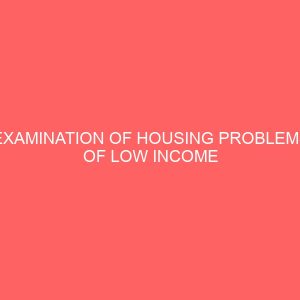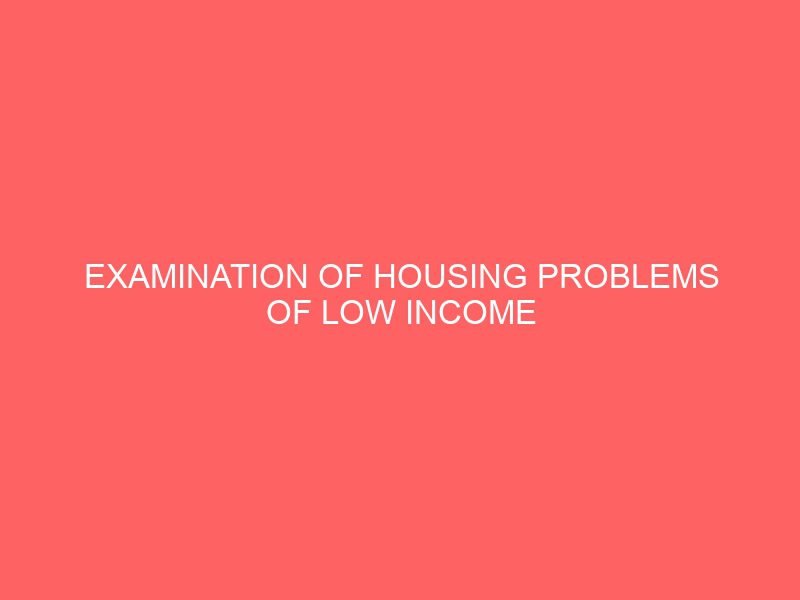Description
Housing problems in low income urban areas in Nigeria 2010-2023 (Case study: Nnewi Locl Government Area, Anambra State, Nigeria).
CHAPTER ONE
INTRODUCTION
1.1 BACKGROUND OF THE STUDY
Housing has a central importance to quality of life with considerable economic, social, cultural and personal significance. Though a country’s national prosperity is usually measured in economic terms, increasing wealth is of diminished value unless all can share its benefits and if the growing wealth is not used to redress growing social deficiencies, one of which is housing (Erguden, 2001).
Housing plays a huge role in revitalizing economic growth in any country, with shelter being among key indicators of development (Ireri, 2010). The universal declaration of human rights gives one of the basic human rights as the right to a decent standard of living, central to which is the access to adequate housing (United Nations, The Human Rights – article 25, 1948). Housing as a basic human right demands that urban dwellers should have access to decent housing, defined as one that provides a foundation for, rather than being a barrier to, good physical and mental health, personal development and the fulfillment of life objectives (Seedhouse, 1986). The focus of this research is housing for low income households or what is commonly known as affordable housing. Affordable housing is a term used to describe dwelling units whose total housing costs are deemed “affordable” to those that have a median income. A median income refers to the average pay scale level of the majority people in a population which is often low. Although the term “affordable housing” is often applied to rental housing that is within the financial means of those in the lower income ranges of a geographical area, the concept is applicable to both renters and purchasers in all income ranges. Low-income housing is aimed at individuals without enough income to provide adequate housing for themselves and/or their families. These families are usually unable to purchase a home because they fail to qualify for a mortgage.
Housing is a major problem in Nigeria especially in Anambra. Millions of people are living in the sprawling slums and also in other informal settlements. Informal settlements and slums in Anambra have continued to grow at an alarming rate in number as well as in population. Table 1.1 shows the growth in informal settlements in Anambra between the year 2017 and 2020.
Table 1.1 Growth in Informal Settlements in Anambra.
| Year | No of Informal settlement | Population | % of urban population |
| 2020 | 36 | 167,000 | 33 |
| 2021 | 50 | 200,000 | 40-50 |
| 2022 | 78 | 789,991 | 55 |
| 2023 | 134 | 1,886,166 | 60 |
Source: Anambra State Urban Archives, 2020.
“Informal settlements” is a generic and technical term that seeks to capture the many different features of those settlements that house many of the urban poor in developing countries. The name implies the dominant feature of such settlements is their informality – the fact that they develop outside the existing legal and regulatory framework. The informal settlements are sometimes called “unplanned” or “spontaneous” settlements, which is misleading, since many informal settlements are planned, albeit not in a conventional way, and are not all spontaneous (World Bank, 2003). Demand for housing far surpasses its supply in Nigeria, especially in urban areas that have for long suffered from poor planning, resulting in an increase in informal settlements with poor housing and little infrastructure services. The housing market in Nigeria has over the years faced a huge supply challenge for both government and private sector players. With availability of about 35,000 housing units in urban areas, the deficit remains huge from a growing demand of 150,000 units every year (Terkula, 2010).
Despite some attempts at achieving decent housing for Nigerians, Nigeria has, on the whole, failed to address the dire housing conditions of her population. The situation has been partially alleviated through the activities of the private sector housing developers, who have been a key supplier of housing, particularly in Anambra (Anambra State Urban Archives, 2009). In the year 2010, the private sector commenced construction of housing units worth Kshs. 9.8 billion and registered growth of 6.9% over the previous year (Statistical Abstract, 2008). But despite intensive overall private-sector activity, these private developers have mainly concentrated in the middle and upper segments of the market with relatively little focus on the low-income market.
The low income house units currently constitutes less than 30% of the private development portfolio (Economic survey, 2010), yet this is the segment where the need is particularly acute. In the past, the government took up the role of housing supplier by controlling planning, land allocation, and development and maintaining housing estates. The government has being charged with the responsibility of providing subsidized housing and implementing government housing policies and programmes through tenant purchase, mortgages, rental and rural housing loan schemes. The National Housing Corporation was formed as part of Nigeria’s post colonial housing policy, underscoring the importance of providing decent shelter for all urban workers in the country (Anambra State Urban Archives, 2009). NGO’s have come in to fill in the gap in the housing shortage especially for the low income households. Banks also introduced loans to enable building of infrastructures especially houses for rents and this NGO’s and private individuals are now engaged in a low cost housing development project for its members, and the public.
Other NGO’s involved in policy making and assisting developers in this sector include: National Urban Forum (Nigeria), African Ministerial Conference on Housing and Urban Development (AMCHUD). These housing developers focusing on the low income market cannot adequately meet the needs of the market unless more players from the private sector join in.
There are five models of housing development for low income housing initiatives (World Bank, 2011):
- Sites plus development plan and gradual implementation of services – settlements are planned and surveyed, lots allocated and occupied, and infrastructure gradually implemented.
- Sites and services – mass production of serviced sites in large schemes for resettlement of urban squatters, usually in peripheral land in city outskirts and with basic starter housing units.
- Comprehensive upgrading of existing settlements – wide range of improvements involving different types of infrastructure according to predefined area plan; this is integrated upgrading but undertaken in one go, usually in a two year time frame.
- Development of new housing in new settlement – new infrastructure and housing units are built on empty land; or new housing units on available land in existing serviced areas.
- Redevelopment of degraded existing structures – agreement reached with building landlords for building renovation.
The Rwanda government for example has adopted the model of developing new housing settlements for her population. They have initiated the Imidugudu project. Imidugudu is an 80 household settlement that was set up in 2002, to accommodate refugees who had returned mainly from Burundi. They are grouped settlements modeled along the lines of Israel’s Kibbutz. The model is being replicated in the whole of Rwanda to accommodate her population decently (Rwanda Report, 2010). Hence this study is focus on examining housing problems of low income urban families using Nnewi town of Nnewi local government of Anambra State.
1.2 STATEMENT OF THE PROBLEM
Provision of adequate, affordable and decent housing for low income urban households is clearly in short supply. The players in this industry are too few and there seems to be a minimal interest of other private sector housing developers to provide low income housing units. These private sector developers as by their success in the middle and high income housing markets, implies that they may have the capacity and skill set to supply the low-income housing required to alleviate, at least partly, the housing shortfall in the country (Anambra State Urban Archives, 2009). But they have shied away from the low income market mainly because the profitability margins are lower as compared to housing developments for the other markets.
There are also many other factors affecting the supply of housing from private sector housing developers prominent of which is the cost of production and the opportunity cost to the developer’s finite funds in either providing middle income housing or high income segment housing or low income housing. The developers have to consider the rate of return to their investment and how fast they’ll realize this. But these are not the only factors affecting the supply of low income housing and the other factors should also be put into consideration. Provision of low cost housing to the increasing number of lower and middle income classes in the country has also been hugely affected by the cost of land and inadequate infrastructure (Terkula, 2010).
The problem that this research seeks to address is that of the shortage in housing supply for low income households and the challenges faced by both existing and potential developers in this market. Issues to be addressed in this research study include the factors affecting low income housing supply, the motivating factor to existing developers in venturing into this market and the housing models they
have adopted in their projects.
1.3 RESEARCH OBJECTIVES
The purpose of this study is to identify housing problems for low income urban families. It seeks to achieve the following objectives:
- To identify the motivation behind the players in the housing industry.
- To analyze the methods of housing provision by existing housing developers for the low income urban families.
- To examine the challenges faced by housing developers in the low income market and hindrances to their efforts.
- To evaluate the practice and effectiveness of current government policies regarding the ensuring housing of low income earners.
- Assess the existing roles and nature of involvement of NGOs and community groups within concurrent housing practices.
- Evaluate institutional arrangement and organizational responsibilities to identify support to impediments of community participation.
- Investigate instances of effective community participation in low-income housing provision for low income urban earners.
- To evaluate the challenges faced by low income urban people in accessing housing.
- To consider how best to manage the challenges identified so as to increase rate of housing provision.
1.4 RESEARCH QUESTIONS
The research was guided by the following key questions:
- What is the motivation behind the players in the housing industry in the Nnewi local government of Anambra state?
- What methods of housing provision do existing housing developers adopt for the low income urban families in Nnewi local government of Anambra state?
- What are the challenges faced by housing developers in the low income markets in Nnewi local government of Anambra state?
- What challenges do low income urban people in Nnewi local government of Anambra state face in accessing housing?
- In which ways can the challenges identified be managed so as to increase rate of housing provision?
1.5 RESEARCH HYPOTHESIS
The following research hypothesis derives logically from the problem posed in the research questions.
Hi: There are challenges faced by low income urban people in Nnewi local government of Anambra state in accessing housing.
Ho: There are no challenges faced by low income urban people in Nnewi local government of Anambra state in accessing housing.
1.6 SIGNIFICANCE OF THE STUDY
This research study will be of benefit to the following key stakeholders in the housing industry:
Affordable housing is one key area for social enterprises. A social enterprise is any business venture created for a social purpose. The research highlighted potential challenges to new social entrepreneurs venturing into this market allowing them early opportunities to overcome these obstacles in order to succeed in the low income housing market. This study findings will therefore assists housing social enterprises in overcoming challenges associated with provision of housing.
The outcome of this research highlighted key areas where private developers require reform, change or incentives in order to enter the low-income market. With this knowledge, developers can lobby for change and policy reforms as well as harness the collective strength of their developers to tap into the lower income market.
1.7 SCOPE OF THE STUDY
The study of the examination of housing problems of low income urban families is restricted to the Nnewi local government area of Anambra state. Limitations beyond this researcher´s control were exaggerated views and responses from some participants just in an effort to impress and due to inherent fear of victimization in the accessibility of housing especially in Nnewi town. However, assurance of no evil intentions in the research was repeatedly expressed to the participants.
Although the researcher strongly believes the similarity of housing problems faced by low income urban familiesin the community, a particular limitation exists to this study in terms of location of the case study; that is the fact that the sample was taken from only one particular community of Nnewi town
1.8 LIMITATIONS OF THE STUDY
- Network interconnectivity to enhance elaborate research
- High level of illiteracy
- Organization operational huddles.
- Time and cost constraints due to cause of scarcity in gasoline to go about the research.
1.9 RESEARCH METHODOLOGY
The research design is according to Mbachu (2005) a plan or strategy for conducting the research, the design deals primarily with the question to be asked, to whom, how and when. The objective of a proper research design is to obtain as much valid information as quick as possible. This follows the fact that according to Mbachu (2005:109) once the research problem has been adequately formulated to specify the type of information needed, the researcher must work out his research design, as a plan, the research design deals with such things as population of the study, sample size, instrumentation, strategies for data collection etc.
Therefore, for this study, survey design was used to collect, collate and analyze data for this study employing the instrumentation of interview and Questionnaires as the methods for gathering data for this study. This is because according to Jekins, stack and McDermont (2003:4) Survey method is the most appropriate design in communication research that gauges and ascertains the feeling and perception of a cross section of the people on the process and effects of mass communication.”
This complete final year research academic project work for undergraduate students is on: Housing problems in low income urban areas in Nigeria 2010-2023 (Case study: Nnewi Locl Government Area, Anambra State, Nigeria).







Reviews
There are no reviews yet.